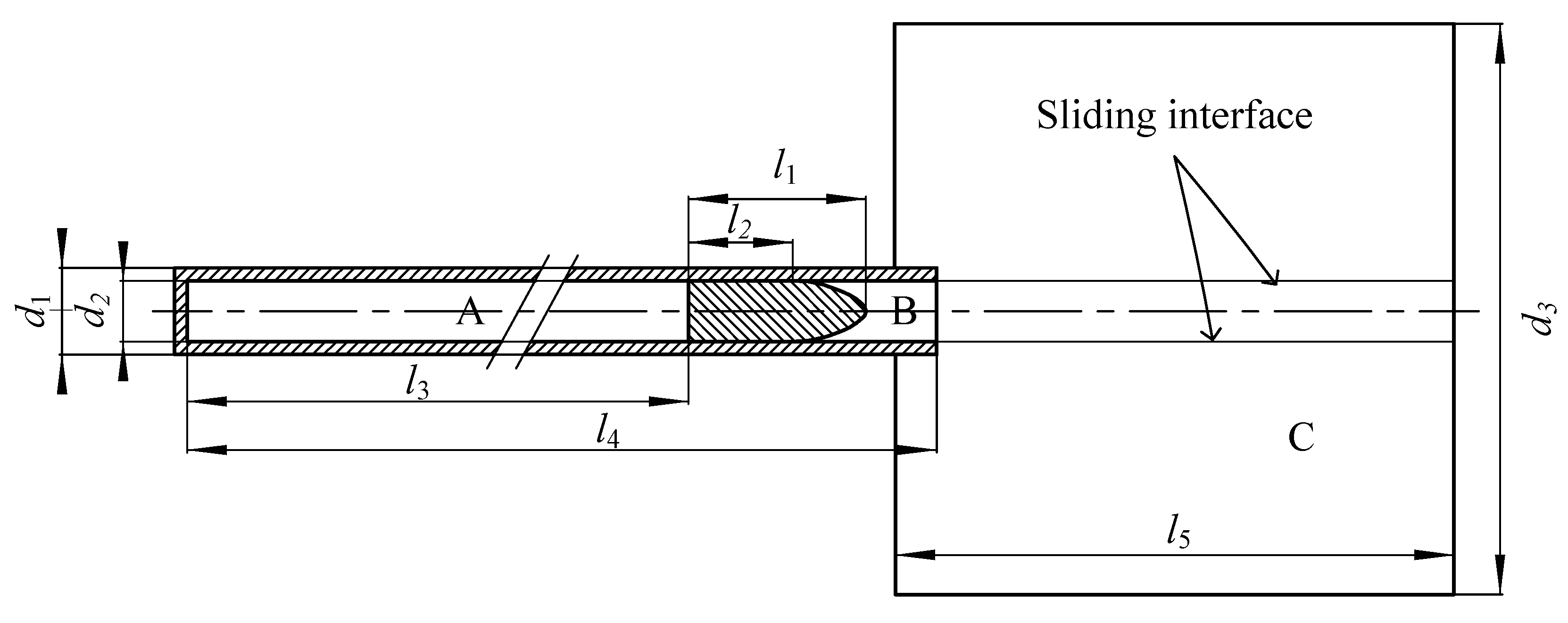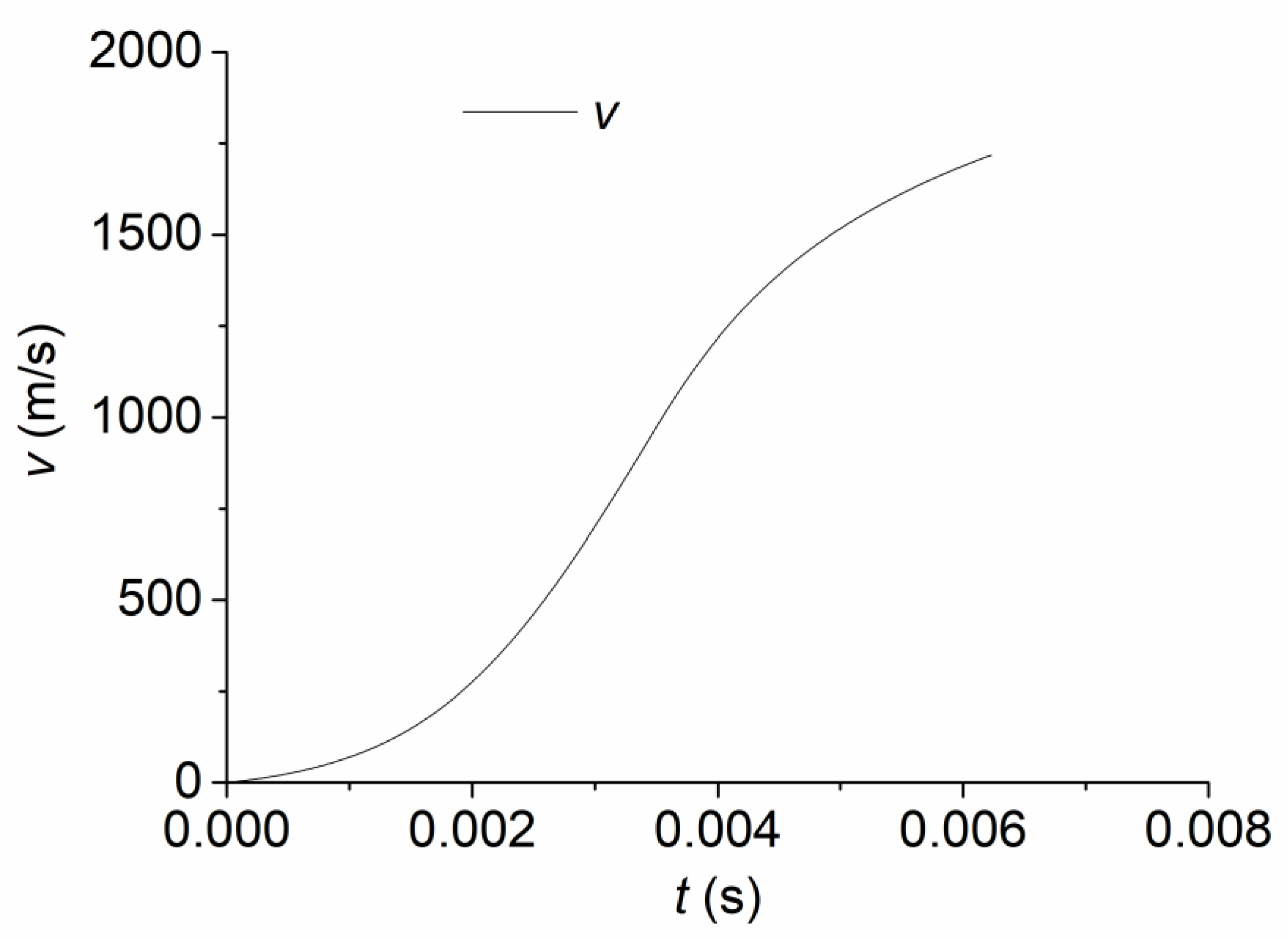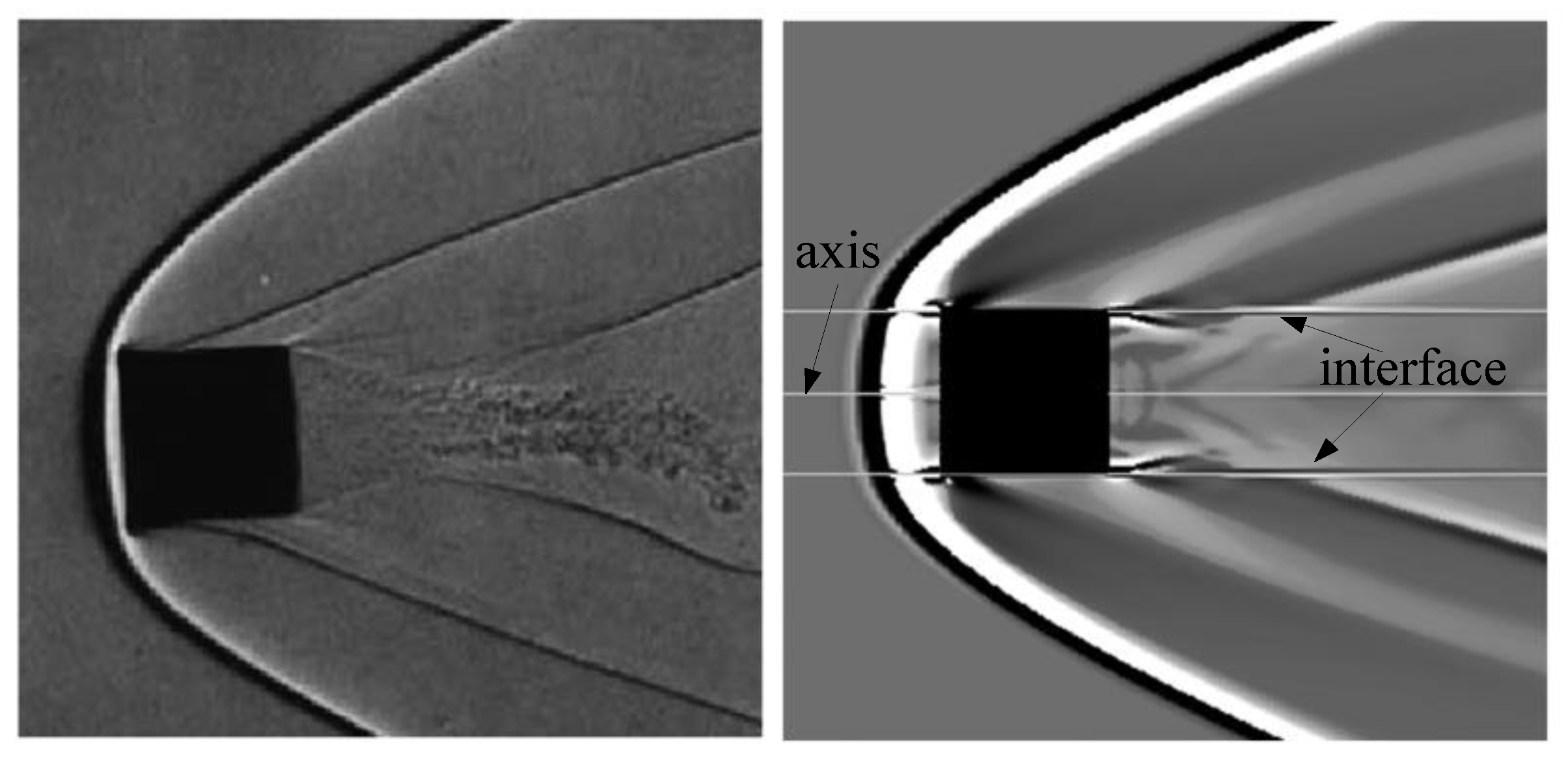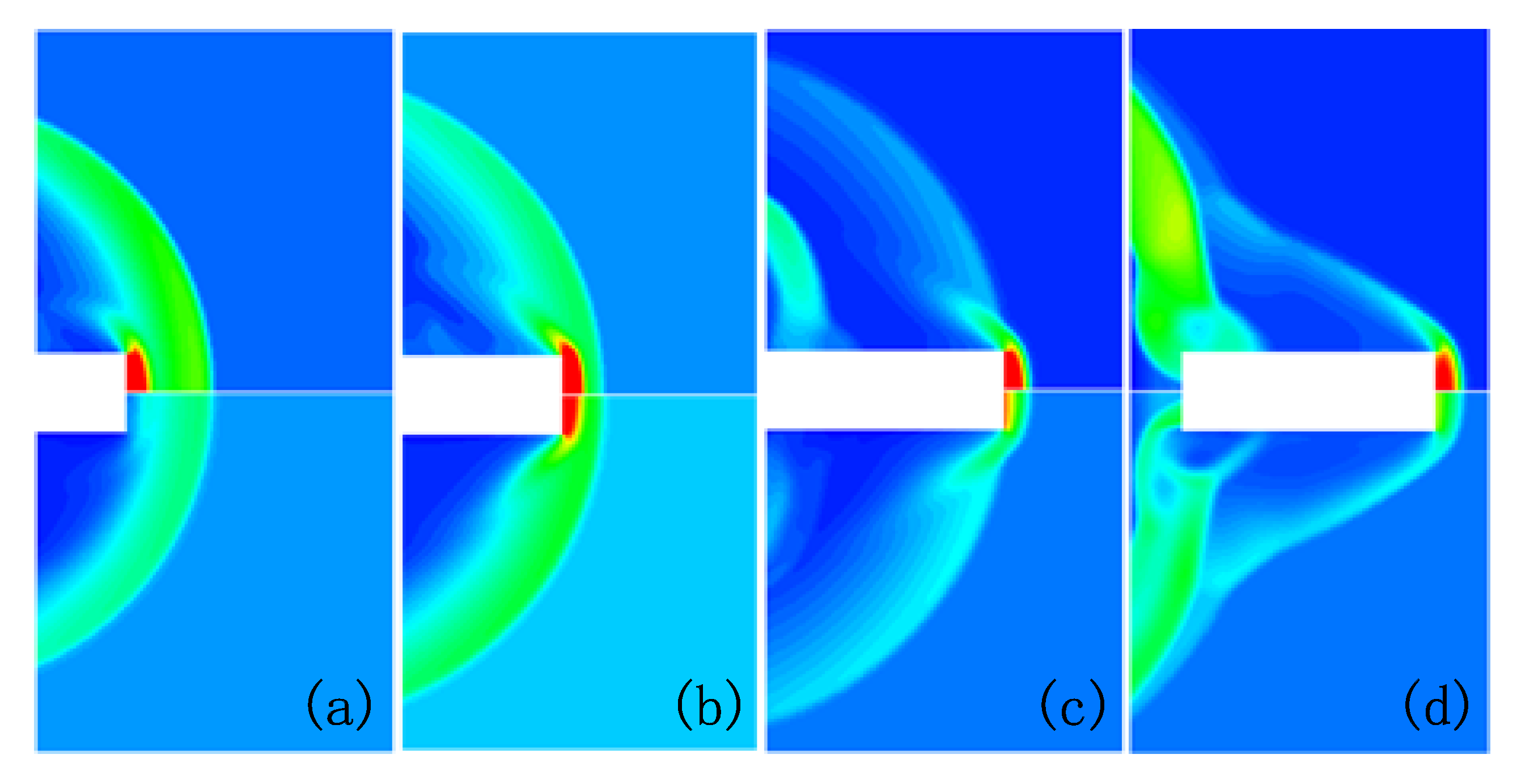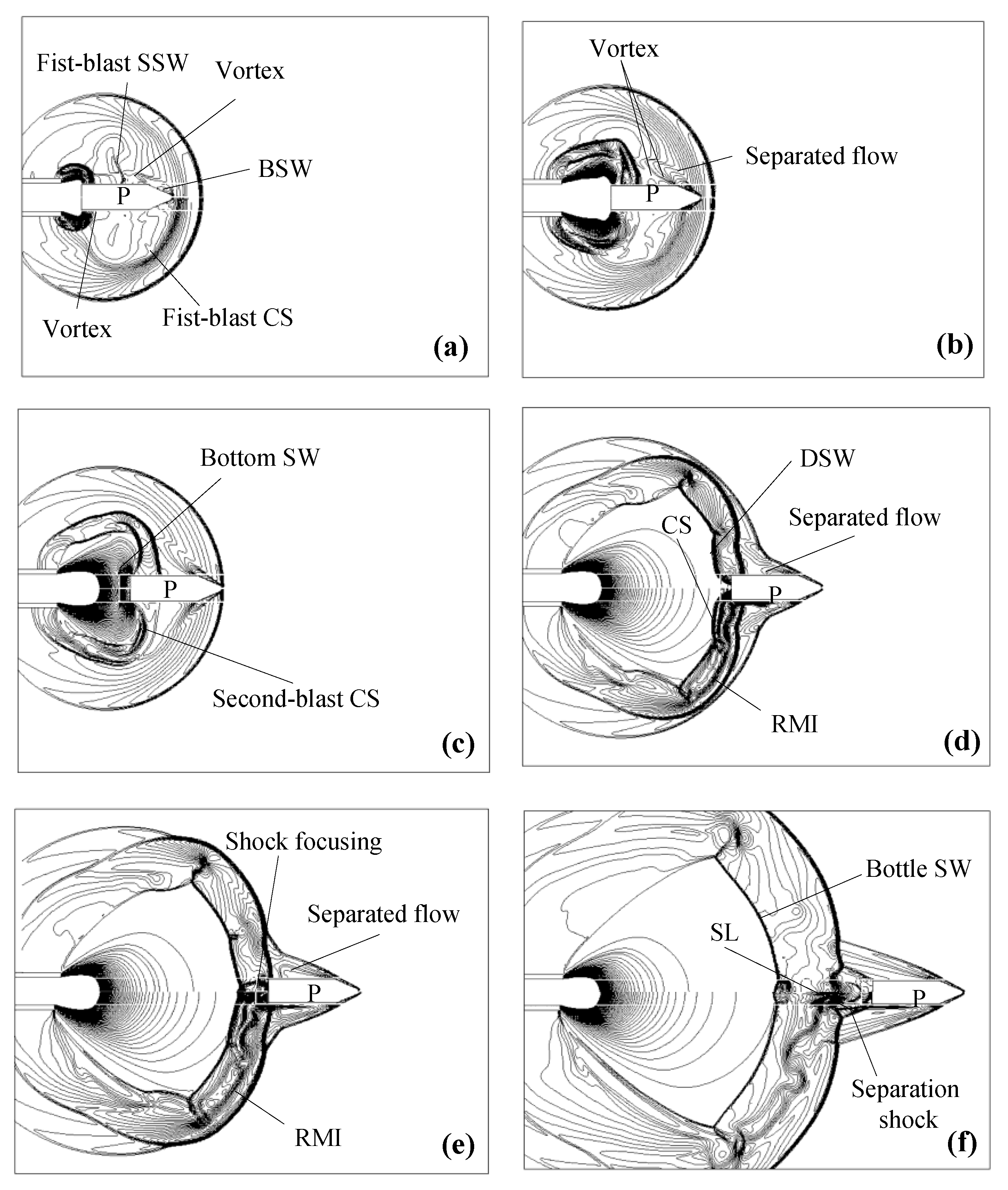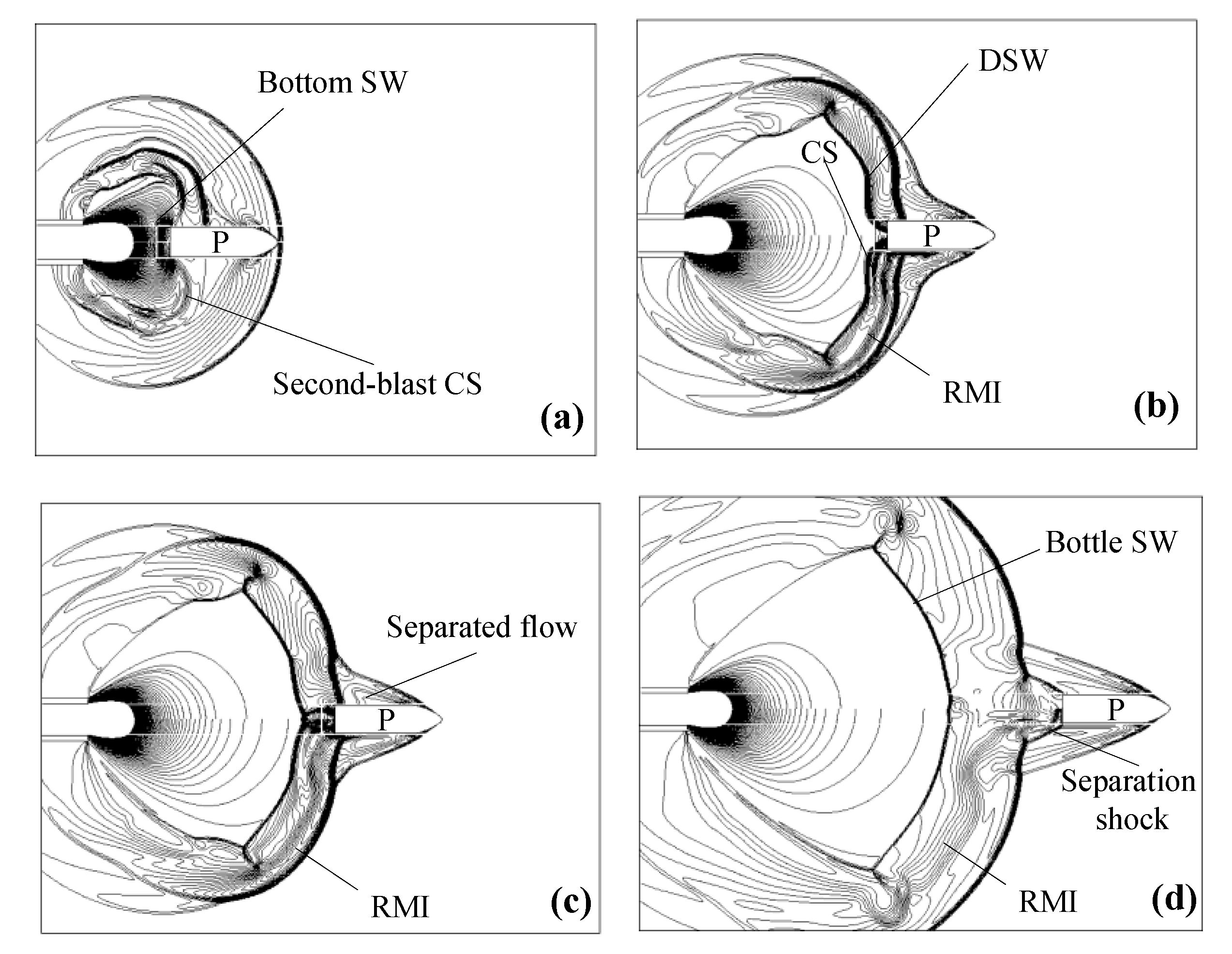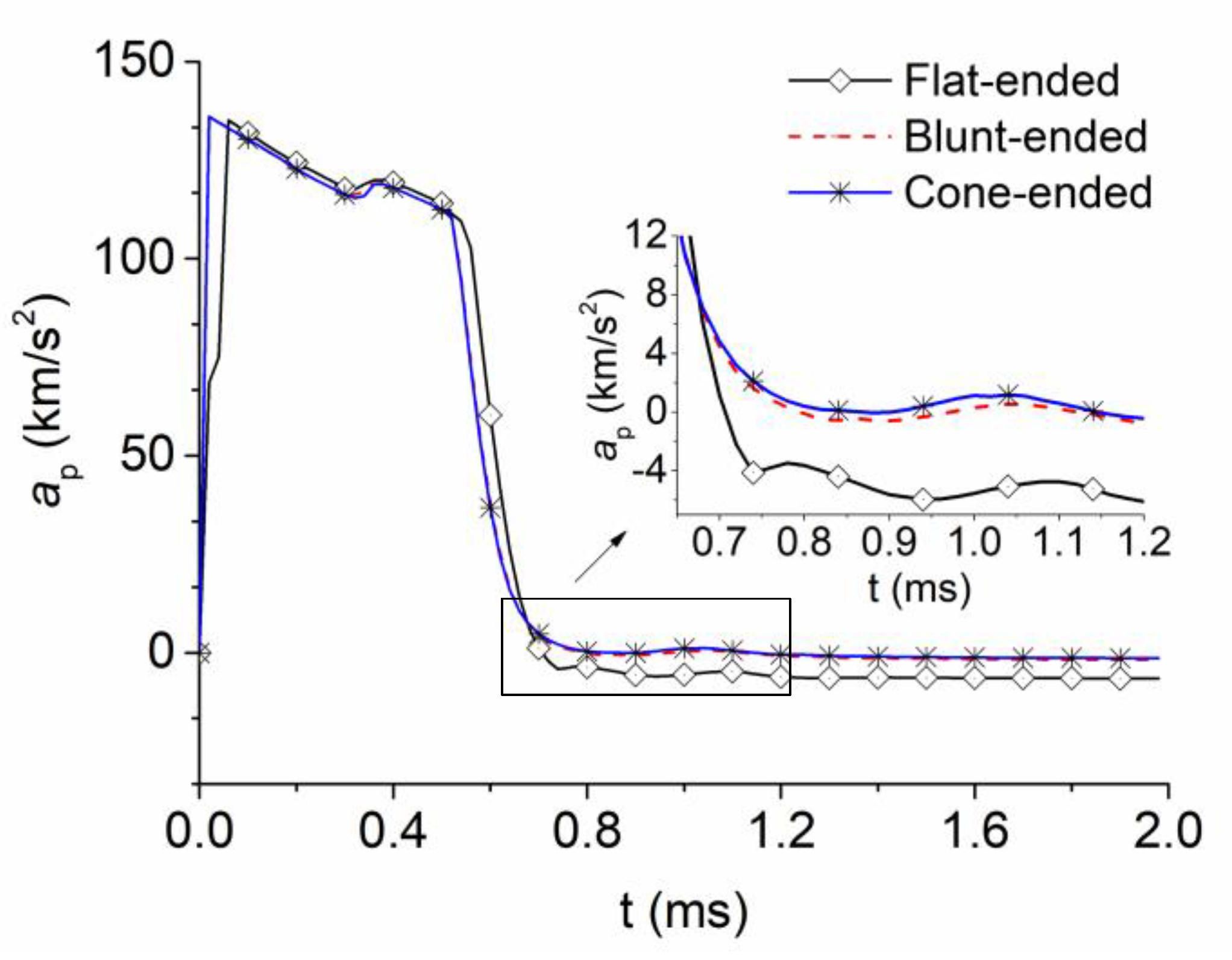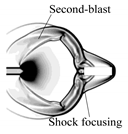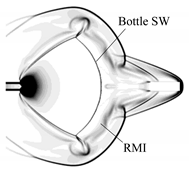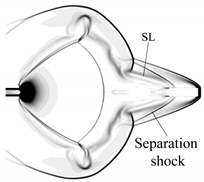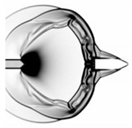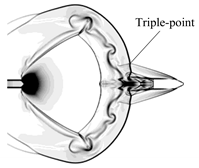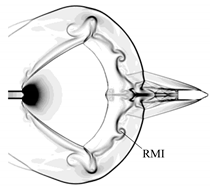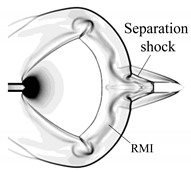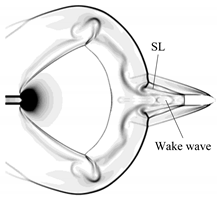The following discussion considers the shock–contact surface, shock–shock, and projectile–shock interactions for different shapes of projectiles, and the generation process of the bow shock wave in detail.
4.1. Case 3: Flat-Nosed Projectile
The results sorted with respect to time for Case 3 are shown in
Figure 7. In order to distinguish the contact surface and shock waves, the figure is divided along the axis of symmetry. The upper half of the figure shows the pressure contour, and the lower half shows the density contour. The numbers of contour levels are set 50 and 70 for pressure contours and density contours, respectively, in order to make the features of interest more prominent.
Figure 7a shows the muzzle flow field characteristics at
t = 0.271 ms. At this time the projectile is located close to the muzzle, the airstream rushes out of the barrel and forms the first-blast around the muzzle. The high-speed airstream shears the still air outside the bore after the ejection from the muzzle and forms the SL. A low-pressure zone is then formed in the rear region, which causes the airstream to flow in reverse towards the external wall of the barrel and forms the primary vortex ring. After ejection from the muzzle, the precursor shock wave (PSW) develops nearly spherically in the air. The front of the SSW and CS develop spherically along the axis. In the radial direction, under the effect of the primary vortex ring, the edge of the SSW is entrained into the low-pressure vortex core, and the “coronal” front is formed. The CS is then entrained into the vicinity of the muzzle so that the air initially in the bore and in front of the projectile is restrained. Therefore, the area between the muzzle and the SSW forms an under-expanded region.
Figure 7b shows the muzzle flow field characteristics at
t = 0.472 ms when part of the projectile has exited the muzzle and the first blast further develops in the external flow field continuously. The energy of the first-blast attenuates gradually during its propagation and replenishing energy is impeded due to the “blocking” effect of the projectile on the gas behind the projectile. Therefore, the flow characteristics begin to weaken. This weakening causes the attenuation of the primary vortex ring, declined propagation speed of the PSW, declined height of the SSW, and reduced the range of the CS. Since the movement of the projectile is faster than that of SSW, the projectile gradually catches up to the SSW and squeezes the under-expanded region, causing reduced volume and a corresponding increased density in this region. As the projectile moves, the small vortex formed around the corner point of the muzzle by the initial jet flow is absorbed by the sidewall of the projectile and moves with it. Simultaneously, the SSW deforms under the squeezing effect of the airstream in front of the projectile.
Figure 7c shows the muzzle flow field characteristics at
t = 0.590 ms when the projectile base exits the muzzle and the gunpowder gas in the bore begins to exit which forms the second-blast. The second blast is composed of the LSW, the SSW and the CS. Among these, the CS of the second blast separates the airstream disturbed by the first-blast from the second-blast flow field. A non-circular wavefront is created at this moment because the second blast moves through the non-uniform flow field caused by the first blast. When the projectile nose is located in the expanded region, because of the high airstream velocity and subsonic movement of the projectile relative to the airstream, the BSW does not appear at the projectile nose. When the projectile nose rushes out of the SSW of the first blast, the movement relative to the air in front of the projectile becomes supersonic. Therefore, a detached BSW with high intensity is formed in front of the projectile nose. The SSW diffracts at the corner of the projectile, causing a drastic change in the flow field near the corner and producing a vortex. The vortex moves backwards along the projectile wall under the effect of the detached boundary layer flow induced by the BSW and drives the backward movement of the SSW. Additionally, the CS becomes rarefied during its propagation prior to reaching the BSW.
Figure 7d represents the muzzle flow field characteristics at
t = 0.671 ms when the BSW is about to encounter the PSW. At this point, the second blast continues to expand. Since its axial velocity is greater than that of the projectile, the gas stream surpasses the projectile base. From
Figure 7c the rightward movement of the second blast and leftward movement of the SSW of the first-blast exist along the sidewall of the projectile. These two shock waves encounter and interact with each other in
Figure 7d, causing the deformation of the LSW. The CS of the first blast is distorted under the effect of the BSW.
Figure 7e shows the muzzle flow-field characteristics at
t = 0.736 ms. From the principle of wave superposition, the SSW of the first-blast and that of the second blast move towards each other and maintain their respective characteristics. A disturbance is created at the point of intersection that then propagates radially. The first triple-point is caused at the point of intersection by the BSW catching up with the PSW. The velocity of the gas jet flow is far greater than that of the projectile. Therefore, the airstream behind the projectile is compressed, and the projectile base shock wave is formed. When the separated flow encounters the LSW, the wavefront is distorted. Due to the high velocity of the projectile, the intensity of the BSW is high, and the velocity and pressure of the separated flow behind the wave are also high. After the separated flow of the boundary layer is formed, a positive pressure gradient is formed on the side of the projectile. This pressure gradient drives the separation point upstream until a balance is reached. A concave reversed flow occurs at the separation point, and a separation shock wave is produced at the reversed point and intersects the LSW.
Figure 7f shows the muzzle flow field characteristics at
t = 0.989 ms when the LSW is about to catch up with the PSW. At this moment, the SSWs formed in the two blasts are combined and form a new shock wave. The disturbance causes the upper edge of the SL of the second-blast to twist. With the attenuation of the wave and the decline of the powder gas ejected from the bore, the velocity of the wave reduces. The SSW of the second blast is gradually separated from the projectile. When the projectile exits the shock cell, the shock wave diffracts at the tail of the projectile. This leads to the absorption of the CS of the second blast on the rear of the diffraction waves. After the LSW sweeps through the non-uniform region behind the PSW, the Richtmyer–Meshkov instability (RMI) phenomenon is induced and evolves with the movement of the LSW.
Figure 7g shows the muzzle flow field characteristics at
t = 1.091 ms when the LSW merges with the PSW and interacts with the BSW to form the second triple-point. At this moment, the first triple-point vanishes. The diffraction shock waves at the projectile base gradually converge at the axis of symmetry and form a cylindrical shock focusing effect at the projectile base. The shock waves then detach from the projectile base, gradually vanish, and eventually form a stable bottle shock wave in the muzzle region at
t = 1.371 ms, as shown in
Figure 7h. Moreover, the separation shock wave settles at the middle of the sidewall of the projectile.
Figure 7f–h show the development of what appears to be a RMI. The RMI occurs when an interface separating two different fluids is impulsively accelerated. After the shock impact, the interface is hydrodynamically unstable and eventually turbulent mixing dominates the flow [
23]. The instability is induced by the LSW. When the LSW sweeps over the CS of the first-blast in the radial direction, the instability develops very quickly and becomes significant. The interaction between the separated flow and the CS aggravates the instability to some extent. The generation of the RMI can be observed more clearly from Schlieren images, which indicate the density gradient.
Table 3 shows the time sequence of Schlieren photos of the RMI development obtained using numerical simulation in time sequence, corresponding to
t = 1.091 ms,
t = 1.615 ms and
t = 1.833 ms. It can be observed from the photos that at
t = 1.091 ms, in the vicinity of the CS, only a small disturbance exists. The disturbance then develops rapidly and causes the rotation and distortion of the CS.
In addition,
Figure 7c–f show the process of the BSW being created, chasing, and surpassing the PSW, from
t = 0. 590 ms to
t = 0. 989 ms. To illustrate this process more directly, the contours around the projectile nose at these time are depicted in
Figure 8. The upper half and the lower half of the figure are separated by the axis of symmetry and correspond to pressure and density contours, respectively. In
Figure 8a, when the projectile moves, under the flow stagnation effects, the density and the pressure rise in the region between the front of the projectile and the BSW. However, the projectile is located between the SSW and the CS. Therefore, the density and pressure of the front region of the projectile are relatively low. The maximum values of pressure and density in this region are 0.2 MPa and 1.7 kg/m
3, respectively. The forward-moving projectile compresses the air between the BSW and the PSW, causing a drastic increase in density and pressure. The pressure and density reach maximum values of 5.4 MPa and 10.4 kg/m
3, respectively, as shown in
Figure 8b. At this moment, the BSW begins to merge with the PSW, which leads to an augmentation of the shock wave intensity. In
Figure 8c, the projectile has caught up with PSW, and the intensity of the BSW reaches its maximum, corresponding to a maximum pressure of 5.7 MPa and a maximum density of 15 kg/m
3 in front of the projectile. Then, the projectile flies steadily in the undisturbed air, and the expansion waves between the BSW and the projectile nose are reflected in this region and finally vanish. This process causes the formation of the BSW adapted with the relative velocity of the projectile. This implies the end of the transient process and the formation of a relatively stable flow field and the BSW in front of the projectile. The corresponding maximum pressure and maximum density in front of the projectile at this time are 4.2 MPa and 11 kg/m
3, respectively. Additionally, the series of fan-shaped expansion waves caused at the inflection ahead of the projectile result in a rapid decline of the pressure behind the inflection. Therefore, the projectile nose resistance is primarily due to the BSW created ahead of the projectile.
4.2. Case 4: Cone-Nosed Projectile
The simulation results for the cone-nosed projectile are exhibited in
Figure 9 with a time sequence of pressure and density contours. The contour levels are the same as Case 3 in order to compare the cases at corresponding times. Generally speaking, the dynamic development of muzzle flow field is basically the same as Case 3. Both the first blast and the second blast appear, together with the generation of the BSW at
t = 0. 590 ms, as can be seen in
Figure 7c and
Figure 9a. The SSW of the first blast interacts with the second blast at
t = 0. 671 ms, as can be seen in
Figure 7d and
Figure 9b. The bottom shock wave occurs at
t = 0. 736 ms, as can be seen in
Figure 7e and
Figure 9c. The DSW is formed at the projectile base, and the LSW approaches the PSW at
t = 0. 989 ms, as can be seen in
Figure 7f and
Figure 9d. The shock focusing is formed at the projectile base at
t = 1.091 ms, as can be seen in
Figure 7g and
Figure 9e. The bottle shock wave is formed at
t = 1.371 ms, as can be seen in
Figure 7h and
Figure 9f. However, there are some discrepancies resulting from the difference in the projectile nose shape. The first of these is the interval between the SSW of the first blast and the LSW. This interval is narrower in
Figure 7c, but wider in
Figure 9a. The reason for this is that almost all of the separated flow of the flat-nosed projectile pushes the SSW of the first blast in the direction of the LSW, which is stronger than just the component of the separated flow of the cone-nosed projectile. Another difference is the location of the separation shock on the projectile surface. The separation shock is further downstream in
Figure 7h than it is in
Figure 9f. The reason for this is that a more intense separation shock wave is generated at the projectile nose in the case of the flat-nosed projectile. Therefore, the pressure gradient is increased, which promotes flow separation and causes the separation point to move upstream. This is also an important cause of the earlier emerging time of the separation shock for the flat-nosed projectile compared to the cone-nosed projectile. The last difference between the cases is the development of the RMI. The degree of instability of the cone-nosed projectile is more obvious than the flat-nosed projectile. This is because the velocity of the separated flow for the cone-nosed projectile is faster than that of the flat-nosed projectile, the CS and the separated flow interact earlier, and the intensity is increased. This can be seen in
Table 3 (RMI graph).
4.3. Case 5: Blunt-Nosed Projectile
The simulation results for the blunt-nosed projectile are shown in
Figure 10. Similar to the approach above, the results are compared to the numerical results of Case 3 and Case 4 at corresponding times with the same contour levels. As expected, some phenomena found in the former cases are observed again in this case. However, some differences are observed. For instance, the RMI of the blunt-nosed projectile and the flat-nosed projectile are similar, but the location and the arrival time of the separation shock on the projectile surface for the blunt-nosed projectile are the same as those of the cone-nosed projectile. This is because the BSW intensity of the blunt-nosed projectile is between those of the other two. The Schlieren photos of the last three cases are shown in
Table 3. The wake waves can also be clearly identified in the Schlieren photos.
Figure 11 shows the acceleration and deceleration history of the projectiles. These results give a good insight into the axial force of the projectile. From the charts, the motion of the projectiles is almost constant between the three projectile models with only a few nuanced differences. Assuming that the projectiles are initially at a uniform motion state, the acceleration of the projectile reaches its maximum in a very short time under the given initial conditions of the flow field. Subsequently, with the decline of the bore gas energy and the increase of the resistance in front of the projectile, the acceleration of the projectile drops continuously. Eventually, the projectile flies steadily, and the acceleration approaches a constant value. It is worth noting that at
t = 0.31 ms the projectile nose exits the muzzle and enters the expanded low-pressure region of the initial flow field. Next, the air resistance in front of the projectile declines and causes a slight increase in the acceleration of the projectile. In addition, the acceleration of the projectile falls dramatically between
t = 0.5 ms to
t = 0.7 ms. This is due to the increase in the resistance in front of the projectile caused by the substantial rise in the pressure and the density from the generation of the BSW as the projectile nose passes through the SSW. The decrease in acceleration is also due to the weakened driving effect of the gas on the projectile caused by the sharp decline in the pressure behind the projectile. This decline in pressure is caused by expansion waves as the gunpowder gas behind the projectile rushes out of the muzzle. This driving effect vanishes after the projectile base exits the SSW. It can be seen in the results that the blunt-nosed and cone-nosed projectiles are almost the same regarding variations in acceleration but are significantly different from the flat-nosed projectile. The initial conditions of the gas behind projectile are constant and, therefore, the observed differences are caused by the different resistance in front of the projectile, which is closely associated with the projectile nose area. The stable values of acceleration of the cone-nosed, blunt-nosed, and flat-nosed projectiles are −1361.08 m/s
2, −1849.365234 m/s
2 and −6542.96875 m/s
2, respectively. In the transitional stage of the stable flight of a projectile (t = 0.7 ms to t = 1.2 ms), the fluctuations of acceleration are related to the wake wave, the DSW, the shock focusing, and interactions between SW and CS. However, the amplitude of the fluctuations is relatively low. During the simulated period, although the acceleration and deceleration are large, the duration time is very short. This leads to velocity variations, induced by the projectile nose shape, that are smaller than 0.5%.
